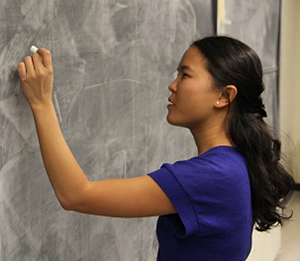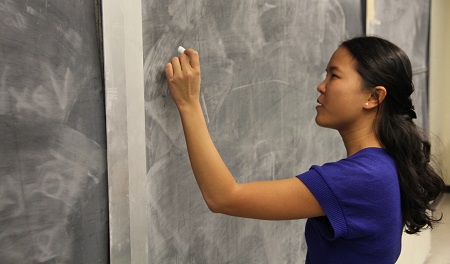Introducing our new faculty members: Felicia Magpantay
January 26, 2018
Share
Felicia Magpantay is one of the 41 new faculty members hired in 2017-18 as part of Principal Daniel Woolf's faculty renewal plans. The Principal's five-year plan will see 200 new faculty members hired over the next five years, which will mean approximately 10 net new faculty hires per year.
This profile is the first in a series which will highlight these new faculty members, like Dr. Magpantay, who have recently joined the Queen's community. She sat down with the Gazette to talk about her experience so far and how she made it to Queen’s.
![[Felicia Magpantay]](/gazette/sites/gazettewww/files/assets/Magpantay%20Gazette%20story.jpg)
Fast facts about Dr. Magpantay
Department: Mathematics and Statistics
Hometown: Metro Manila, Philippines
Research area: Delay differential equation and mathematical biology
Recent books Dr. Magpantay has enjoyed: Ordinary Light by Tracy K. Smith, and The Return by Hisham Matar
Favourite quote: “Ang hindi marunong lumingon sa pinanggalingan ay hindi makararating sa kanyang paroroonan.” “He who does not look back at where he came from will never get to where he is going.”
- Tell us a little about yourself and why you decided to get into teaching.
- I grew up in the Philippines. Before I came to Canada my only experiences abroad were traveling to Bali and Taipei for the International Physics Olympiad. Meeting so many people from around the world encouraged me to dream about going abroad for my university degree.
- I didn’t really think it would happen, but I applied to schools in Canada and received an international scholarship to attend Trent University. I majored in math and physics and eventually decided to go to graduate school in applied math. I went to Western for my masters and McGill for my doctorate. I did a one-year post-doc at York, and two years at the University of Michigan. I accepted my first faculty position at the University of Manitoba in 2015, then moved to Queen’s in 2017. I really enjoyed being in Winnipeg, but Queen’s was overall a better place for me for many reasons including personal reasons.
- My father is a retired physics professor in the Philippines. He grew up in a squatter’s area, the 11th of 11 children. His parents did not complete much schooling, but they always understood the value of education. He was able to go to school on science scholarships and eventually completed his PhD at Purdue University. He went back to serve as a professor in the Philippines in the 1980s.
- Tell us a bit about your research.
- My PhD dissertation was on delay differential equations and numerical analysis. While completing my postdocs, I started working on mathematical biology – basically using mathematical tools to study biological problems.
- My current research looks at how diseases spread in a population. This helps us find ways to explain how control efforts, such as mass vaccination with different types of vaccines, can have different ramifications for the population.
Right now I’m still more comfortable teaching smaller classes where I can use the blackboard, and check in with the students during a lecture to make sure they understand – working at their pace, going through the theorems, and using a lot of examples.

- What is your proudest accomplishment so far?
- Getting here! When I became a professor in Manitoba, a friend wrote an article celebrating my hiring. It is not very common for Filipinos to become professors.
- A common joke is that Filipino parents all want their kids to go into something stable, such as nursing. Many Filipinos also come to Canada through the Live-In Caregiver program. Both of those professions are very honorable and provide important services to society. But there are lots of different jobs out there and so, while I was reluctant to be featured as a ‘role model’ in that article, I recognized the importance of showing people that Filipinos can have a whole variety of careers, including academia.

- Tell us about your teaching style.
- In the fall term, I was assigned to teach a calculus class of more than 600 students. That was by far the largest class I had ever taught and it was quite a challenge. I think it will be an asset to learn how to teach such big classes and how to manage that many students. I am still learning.
- Right now I’m still more comfortable teaching smaller classes where I can use the blackboard, and check in with the students during a lecture to make sure they understand – working at their pace, going through the theorems, and using a lot of examples.
- Anything you do to unwind?
- I used to dance salsa and I haven’t since moving to Kingston – there was too much to do and it takes me a while to adjust to a new place. I also used to dance tango and ballet recreationally. Hopefully once I am more settled in I can resume that in the future.
- What do you feel most grateful for?
- I come from the Philippines, which is still a developing country, and my whole family is still there. I was lucky to be born into a middle-class family who supported me and taught me to value my education early.
- I am lucky to be here – most people in the Philippines would not have the chance to pursue the path I did.
Faculty Renewal
Principal Daniel Woolf has identified faculty renewal as a high priority for reinvestment by the university in support of the academic mission. The five-year renewal plan will see 200 new faculty hired, which nearly doubles the hiring pace of the past six years and will result in approximately 10 net new hires per year.
Faculty renewal supports Queen’s commitment to diversity and inclusion by giving the university the opportunity to seek proactively representation from equity-seeking groups such as women, people with disabilities, Indigenous Peoples, and visible minorities. It will also build on Queen’s current areas of research strength.
To learn more about the Principal’s faculty renewal plans, read this Gazette article. Stay tuned for additional new faculty profiles in the Gazette.